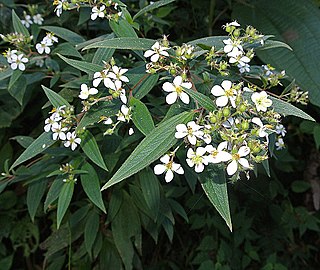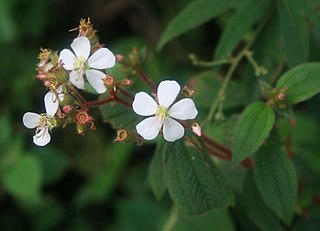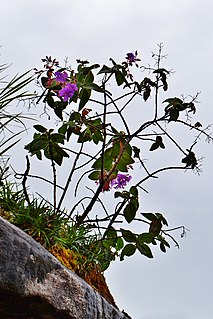
Tibouchina is a neotropical flowering plant genus in the family Melastomataceae. Species of this genus are subshrubs, shrubs or small trees and typically have purple flowers. They are native to Mexico, the Caribbean, and South America where they are found as far south as northern Argentina. Members of this genus are known as glory bushes, glory trees or princess flowers. The name Tibouchina is adapted from a Guianan indigenous name for a member of this genus. A systematic study in 2013 showed that as then circumscribed the genus was paraphyletic, and in 2019 the genus was split into a more narrowly circumscribed Tibouchina, two re-established genera Pleroma and Chaetogastra, and a new genus, Andesanthus.
Chaetogastra anderssonii, synonym Tibouchina anderssonii, is a species of plant in the family Melastomataceae. It is endemic to Ecuador.
Chaetogastra campii, synonym Tibouchina campii, is a species of plant in the family Melastomataceae. It is native to Ecuador.
Andesanthus gleasonianus, synonym Tibouchina gleasoniana, is a species of plant in the family Melastomataceae. It is native to Colombia and Ecuador.
Chaetogastra oroensis, synonym Tibouchina oroensis, is a species of plant in the family Melastomataceae. It is endemic to Ecuador.

Pleroma urvilleanum, synonym Tibouchina urvilleana, is a species of flowering plant in the family Melastomataceae, native to Brazil.

Chaetogastra grossa, synonym Tibouchina grossa, is a species in the Melastomataceae family that is native to Colombia, Ecuador and Venezuela. It is found between 2400 and 3800 meters in elevation. Also called "red princess flower" or "carmine princess flower" to differentiate it from "princess flower" which has purple blooms.
Fritzschia is a genus of flowering plants in the family Melastomataceae, native to the Atlantic coastal forest of Brazil. They are sprawling or erect shrubs, with their branchlets and their hypanthia coated with either glandular or villose trichomes.

Chaetogastra is a genus of flowering plants belonging to the family Melastomataceae. Its native range is South America and North America. It contains around 115 species.

Pleroma is a genus of flowering plant in the family Melastomataceae, native from Puerto Rico and the Leeward Islands to tropical South America.

Andesanthus is a genus of flowering plant in the family Melastomataceae, native to Colombia, Costa Rica, Ecuador, Panama, Peru and Venezuela. The genus was established in 2019 for some species formerly placed in Tibouchina. Some species are cultivated as ornamental shrubs or trees.

Chaetogastra longifolia is a species of flowering plant in the family Melastomataceae, native to Mexico through the Caribbean to northern South America. It has many synonyms, including Tibouchina longifolia. It was first described in 1797 by Martin Vahl as Rhexia longifolia.

Chaetogastra mollis is a species of flowering plant in the family Melastomataceae, native to western South America. It was first described by Aimé Bonpland as Rhexia mollis in part of Monographia Melastomacearum, volume 2, published in 1808. Its synonyms include Tibouchina mollis.

Chaetogastra ciliaris is a species of flowering plant in the family Melastomataceae, native to Colombia, Costa Rica and Ecuador. It was first described as Meriania ciliaris by Étienne Ventenat in 1807. Its synonyms include Tibouchina ciliaris.

Chaetogastra gracilis is a species of flowering plant in the family Melastomataceae. It is native to much of South America, from Venezuela in the north to northeast Argentina in the south. It was first described in 1823 by Aimé Bonpland as Rhexia gracilis. Its synonyms include Tibouchina gracilis.

Pleroma francavillanum is a species of flowering plant in the family Melastomataceae, native to Brazil. It was first described by Alfred Cogniaux in 1885 as Tibouchina francavillana.

Pleroma pereirae is a species of flowering plant in the family Melastomataceae, native to Brazil. It was first described in 1961 as Tibouchina pereirae.

Chaetogastra clinopodifolia is a species of flowering plant in the family Melastomataceae, native to south and southeastern Brazil. It was first described by Augustin de Candolle in 1828. One of its synonyms is Tibouchina clinopodifolia.

Chaetogastra rufipilis is a species of flowering plant in the family Melastomataceae, native to Mexico. It was first described by Diederich von Schlechtendal in 1839 as Rhexia rufipilis. One of its synonyms is Tibouchina rufipilis.

Chaetogastra versicolor is a species of flowering plant in the family Melastomataceae, native to Brazil. It was first described by John Lindley in 1827 as Rhexia versicolor. One of its synonyms is Tibouchina versicolor.

















